I’ve had a pretty long and storied career both playing and writing about Assassin’s Creed games. I first got into the series through Assassin’s Creed II, then Assassin’s Creed: Brotherhood and followed with every mainline game since then. I’ve had a lot of mixed thoughts on the franchise, but I do enjoy the older AC titles a lot more than the recent RPG laden Assassin’s Creed Origins and Assassin’s Creed Odyssey. Not because they are bad games perse, but more so because they are incredibly bloated. And while Assassin’s Creed Valhalla still falters some compared to others in the Assassin’s Creed line, it is certainly better than both Origins and Odyssey.
Review: Assassin’s Creed Valhalla
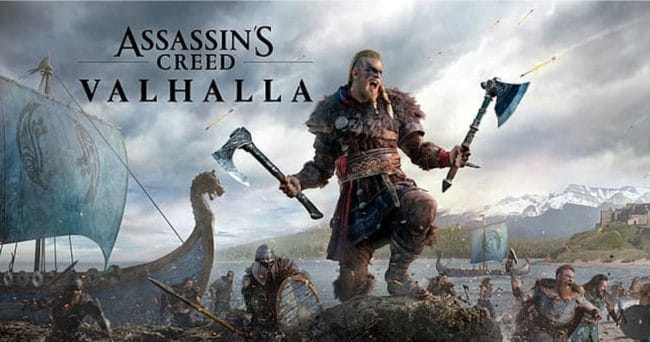
Name: Assassin’s Creed Valhalla
Platform: PS4 [Reviewed], Xbox One, PC, Xbox Series X, PS5
Developer: Ubisoft Montreal
Publisher: Ubisoft
Genre: Action Adventure
Players: 1
Release Date: November 12th, 2020
Price $59.99 (USD)
I wanted to go ahead and explain something. Firstly, I played the PlayStation 4 version of the game on a PlayStation 5. Also, much of this review will get nitpicky and long in spots. Assassin’s Creed Valhalla is almost a return to form for the franchise. It’s not a perfect game and it does have some faults, to be sure. But considering my views on the previous two games that I outlined above, Valhalla takes many important steps in getting the franchise back on track.
The Story

From a narrative standpoint, the story is actually pretty solid. I did choose to play as the male version of Eivor, so I’ll be referring to Eivor as “he”, “him”, etc. When the game starts you off, you’re playing as a young male, so I assumed that was kind of the default. There’s a really weird hook where the present-day people claim that there are multiple DNA streams, which is what allows for the gender-switching option, which seems really silly. Apparently, Eivor is actually a female name, so if they wanted me to play as a woman, they should have started with that. However, if you would like, you can switch genders at any time, and there’s even a both gender option as well.
Eivor’s journey begins with him as a lad at a Viking celebration. The celebration gets attacked and his parents end up dead. Eivor is taken in by the clan chief and raised as a surrogate child along with his own son. About 15 years later, Eivor and his surrogate brother, Sigurd, eventually leave the clan and Norway to settle in England and raise an army for themselves. From there, machinations start against a few, centuries-old organizations with Eivor doing his best and killing a whole bunch of folks.
Present Day
While I won’t go too in-depth about the present-day storyline, it is wonderful to have Shaun and Rebecca back in the game. And unlike how they tried to replace John de Lancie’s William Miles in Assassin’s Creed Origins, they got back Danny Wallace (Shaun) and Eliza Schneider (Rebecca) as well. Hearing these two banter back and forth again put me in a happy mood.
Put simply, Layla’s story arc doesn’t end on the most satisfying conclusion. Part of this is because she was never really a great character. They didn’t introduce her right. Also, her motivations always seem a bit fuzzier as compared to Desmond’s. Plus, she doesn’t really do much in this story, as a whole. But saying anything more might spoil the game.
A Home To Go Back To
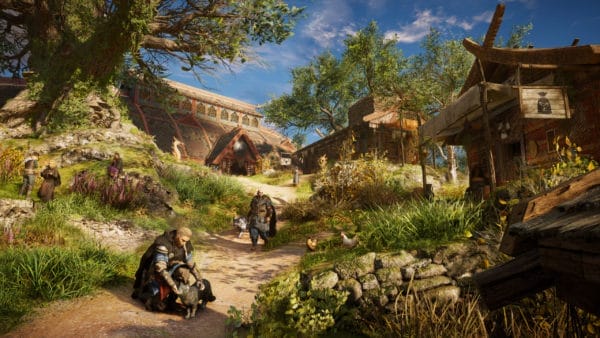
Pretty much the first thing you do once you hit England is you set up your own settlement. This is your own village that you can build, upgrade, and talk to various story characters. It’s very much like the Villa area from Assassin’s Creed II, or more akin to the Homestead from Assassin’s Creed III. You don’t have complete control in this place like you don’t get an income or you can’t recruit anyone to live there, but it’s still a very welcome change.
One reason this is nice is that it actually provides some element of narrative stability to the game. Both Origins and Odyssey had an issue of “Well, I’m done with this area, time to move onto the next.”, so you really had nothing to back to at all. Both those games had a real dearth of side characters because most of them were so disposable that they didn’t make much impact. Not every character in Assassin’s Creed Valhalla is great but seeing Randvi, Tarben, Petra and Yanli, to name just a few, make the Ravensthorpe settlement a much more lived-in place.
Speaking of your settlement, there are the normal shops you build such as a trading post, blacksmith, stables, and a boat dock. However, it’s also home to a lot more specialized shops that aren’t anywhere in the game. There’s a cartographer that sells you maps, a hunting outpost for legendary animals to kill, an Assassin’s Den to keep track of the Templar Order and more.
Alliance Map
If anyone has played Dragon Age: Inquisition, you’ll be familiar with the War Table. This was basically a map of the area where you could elect to send your party out to do missions. Plus, it also where you would select to do the next story beat. Assassin’s Creed Valhalla has basically the same thing called the Alliance Map, only here you don’t send units out and it actually makes a bit of sense. The one in Inquisition was a little too convoluted for its own good and oftentimes you never had a real sense of progression. In Valhalla, this is perfectly clear almost from the get-go.
The basic flow of the game is, you want to go to an area and establish a pact with Jarl, King, or whoever is in charge. They will typically task you with between 8 and 12 missions. After finishing those, the area’s questline is done. Then you move onto the next one. Each area has a general level requirement, going up to 340, and they all have general minimums to start them with some gated by story progress.
This Alliance Map thing works for two reasons. One is, it actually gives you a reason to go to every region in England. This world is fairly large, though thankfully NOT as huge as Odyssey or Origins. However, having actual reasons to go to every region and continue on with the story is nice. The second is that it helps to further cement why the settlement is essential, which is where you go to start and finish these alliance storylines, and you’ll meet even more memorable characters as you progress through them.
Raiding? What is this, World of Warcraft?

Raiding is one of the big new gameplay systems in Valhalla and I’d call it fine? They aren’t as silly as battles in Odyssey, at least, which were completely pointless Also, there are only about 12 or 14 total raid locations to actually do.
To start them, you have to be in your boat, and then find a raidable village or monastery. Then, point your boat at them and select Raid from the menu. After that, your boat automatically runs ashore, your warriors get out and you can start slaughtering the enemy soldiers.
The only real objective of these raids is to get supplies and raw materials for your own settlement. These two resources are what allows you to actually build and upgrade buildings in your place, so they are fairly critical. I managed to get a lot of supplies for my town by doing quests, or just occasionally finding them. However, raw materials are an entirely different matter. In order to fully upgrade your town, you are almost obligated to do every raid. Mainly because raw materials are in such short supply.
Although, raids aren’t all about combat in Assassin’s Creed Valhalla. While you do murder a bunch of enemy soldiers, the major goal are the cooperative chests, which house the materials and supplies you need. You do this by walking up to a big treasure chest and hit the open button, while an AI soldier runs up to help open it. Sadly, this doesn’t always work as intended, but I’ll get into that later.
Gear Leveling
Unlike the past few AC games, which were damn near loot-driven games, there’s not actually a ton of different gear in Valhalla. Don’t get me wrong, there are dozens of weapons and armor pieces, but it feels very restrained compared to the past games. I pretty much used the starting weapons/gear for 99% of my time in the game, just upgrading them when I could until they were maxed out.
All gear has three levels of quality: bronze, silver, and gold. When you get an item it’ll generally be bronze, or even just “basic” (no level), and you can upgrade it with metal ingots you find in the game world. The level system affects how much its stats can be upgraded and also the number of rune slots it has.
Runes
Runes are a bit more of the customizable aspect when it comes to weapons. You’ll get dozens of different runes in the game that can slot into weapons or armor. Runes can just be flat stat increases like increasing attack or increase resistance to injury. There are also more fun ones like “Lighting your weapon on fire after a critical hit on an enemy.”
Unlike with your gear, you can’t really upgrade runes, so the ones you find at the start of the game are vastly outmatched by the ones you acquire near the end of the game. I do wish there was kind of a Diablo-style system where you could combine two lesser runes into one more powerful one, but alas that’s not the case.
Side Activities
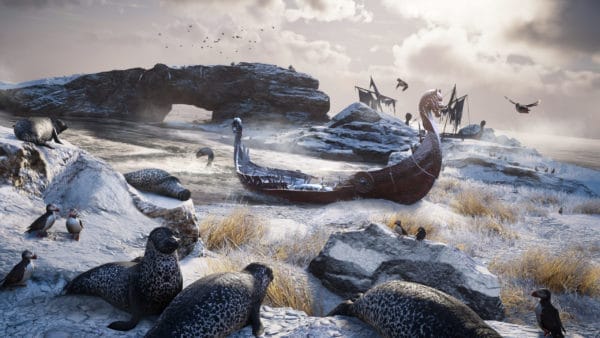
There is actually a fair amount of side content in the game and not just side missions for you to do. I’ll detail a few of the more impressive ones:
- Orlog: Orlog is a dice mini-game where you roll dice against an opponent to eliminate their life points. There are two attack dice, two defense dice, a dye that steals God Power from the other player, and gold-rimmed dice to generate God Power for you. This mini-game can seem overwhelming at first, but once you get the hang of it, it becomes a breeze and really fun to do.
- Flyting Do you like Viking rap battles? Well, here you go! Flyting involves you betting money against a NPC where a rhyme battle occurs. The other character will say two lines (that rhyme), then a third, and you are given three options to rhyme back correctly. If you complete 3 rounds, you’ll win the bet. Most times you’ll be insulting the other person back but some of the battles have different circumstances, so you have to pay a bit of attention.
- Drinking: Like with Flyting, this is a mini-game where you bet money against a NPC. Here, you just have to press X when the ring is in the circle, as you pound alcohol back. You’ll have multiple rounds but you have to get the timing and movement down since you can get behind quickly.
- Treasures of Britain: These are basically like the old tombs from Assassin’s Creed II or Assassin’s Creed: Brotherhood, only not as large. The treasures are more about puzzle-solving and platforming, more than combat.
Sadly, some side stuff doesn’t entirely hit the mark, notably fishing or the Saga stones, but almost all of it is actually enjoyable.
The Constellation Grid
Like with Inquisition above, an odd thing Valhalla borrows from a different game is the Sphere Grid from Final Fantasy X, only instead of spheres its constellations. Basically, you’ll put points into points in a constellation, which improves stats, either offensive or defensive. Increasing health or strength, or even increasing headshot damage, etc. However, each constellation has a main ability that can be unlocked which can help Eivor in combat. These include a counter roll, letting you use two heavy weapons at once, doing a sprinting attack, and so on.
A funny thing Ubisoft added initially, which they thankfully fixed with a patch, was making all of this stuff hidden. Even the main abilities weren’t viewable and hidden by the fog on the upgrade screen. After the patch, you can actually see main abilities but that’s about it. This could have been done in a better way though because as it is, you can’t really plan out your upgrade path well. Still, restarting your points is free, so you can always respec at will.
Book Learnin’
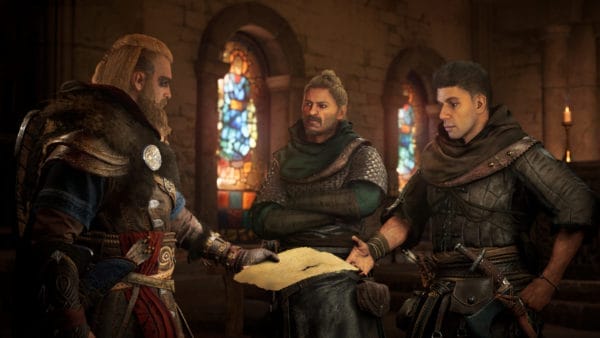
Aside from the skill tree, you also gain abilities via finding Books of Knowledge in the game world. These abilities are slightly more combat-focused than the other ones and are also the ones you’ll slot into your two active slots. When you hold either L2 or R2. Thus, letting you use an active ability, provided you have the adrenaline for it. L2 is for ranged attacks and R2 is for melee ones.
These abilities can also be upgraded by finding other books. Each ability has two rank points, the first one unlocks it, while the second one upgrades it by making it more damaging or giving you a perk when you use it.
General Combat
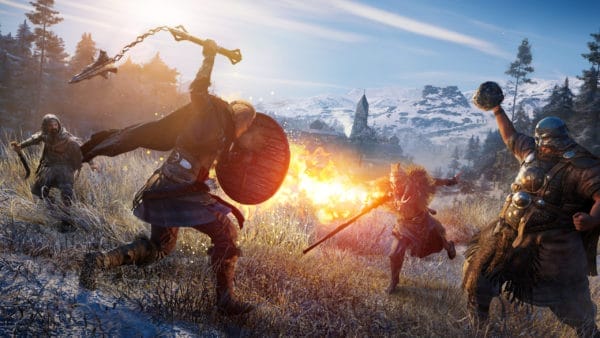
The flow of combat isn’t too dissimilar from Origins or Odyssey. Although it does feel slightly faster. Your main weapon is used for R1 (light) and R2 (heavy) attacks, with the heavy attacks costing stamina. Stamina recharges after a bit so if you use it all up, you’ll just have to wait a few seconds to get it back.
L2 is used for your bow, and L1 is used for your offhand weapon. I primarily used a shield here, to block ranged attacks, but you can pretty much use any weapon you want, provided you have a few skills unlocked. L1 is what you’ll use to parry/counter enemy attacks, which is critical for certain enemies, as each enemy has its own stamina bar. Once it’s drained, you can do a melee attack which is devastating and usually kills all non-boss characters in one shot.
The Hidden Blade Returns
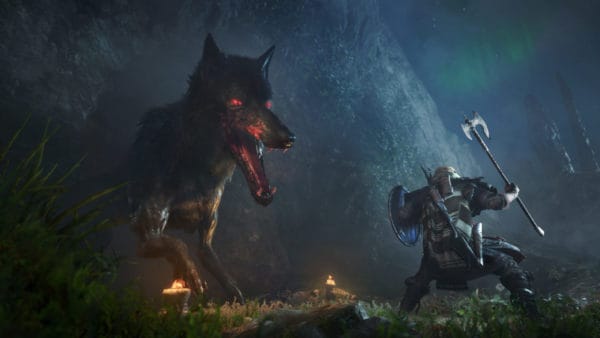
One of the things I least liked about the last two games was the general removal of the Hidden Blade mechanic that the Assassin’s Creed franchise is known for. Both games had facsimiles but they weren’t the real thing. It returns in Assassin’s Creed Valhalla and is great, once you make one change in the menu.
The Hidden Blade can generally kill most enemies with one hit if you are hidden and they are the same level as you, or lower. However, You can actually improve this by unlocking a skill that lets you assassinate everyone. The catch is, it becomes a timing-based QTE where you have to press the button when the meters are overlapping, which I frequently missed.
Thankfully, there is an option in the game called Guaranteed Assassination, which basically makes it like how the Hidden Blade used to be in old AC games. To be fair, Valhalla points out using this option means “you aren’t playing the game as it was intended to be experienced”, but considering they made nine Assassin’s Creed games with the Hidden Blade mechanic, I might argue that this is more in line with how the franchise is meant to be played.
Parkour Problems
A funny thing about Valhalla, compared to other AC games, is how bad the parkour is. To Eivor’s credit, he can pretty much climb on anything, aside from wood-tipped walls or sheer ice. But asking him to be precise when trying to follow a certain path is almost always bad.
Like with AC3, there are floating pages in the game world that you can chase after. AC3 (and 4, and the rest) had much more evolved parkour systems, so your characters would generally go where you want. Eivor controls like a drunken idiot a lot of these times, so instead of swiftly rounding a bend, he’ll try to climb up it, which wastes time and leads to frustration. This is the only real main gameplay system that has actually regressed some, compared to the older games.
Other Issues
There are a few other issues with Valhalla that are sometimes annoying and other times bewildering. Those co-op chests you have to open during raids have a tendency to not work right. Eivor will be pushing at a chest cover to open it, calling anyone to help him, and I’d sometimes have up to seven of my soldiers in the same building, just kind of wandering around, literally bumping into one another.
The framerate for Valhalla isn’t what you’d call “stable” either. Most of the game was fine, but there would be instances, particularly in your own settlement, where the framerate would drop like a rock. I could forgive this if it was some epic battle with dozens of guys on screen at once, but this is literally just me walking around my main hall, or around my town area. I have no idea why this happens and it isn’t screen tearing like what others have seen.
Lastly, there are occasional glitches when you get stuck in mid-air, which generally results in your death, stealth not being reset even when WAY outside the enemy range, friendly NPC’s not moving when you are supposed to follow them, and so on.
Ending on a Positive Note
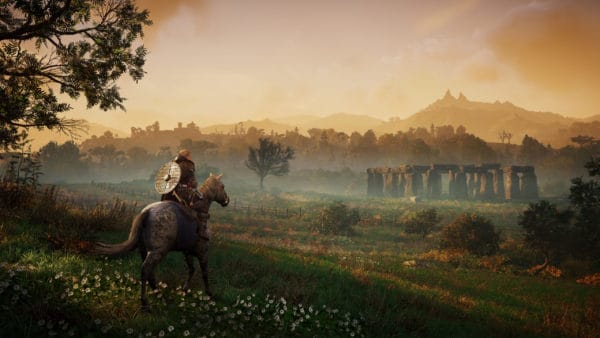
One thing I did really appreciate is the anomaly sequences. Past AC games had this, notably Assassin’s Creed Syndicate, but these are kind of specialized platforming puzzles where you control Layla (while still in England during Animus) and do platforming challenges to get some bit of secret data. You basically have to climb a big, virtual tower, while avoiding traps and opening up the path. I think there’s about 10 of these, and each of them generally has their own unique hook. It’s a nice change of pace from the rest of the game and they are a blast to do.
This game was reviewed using a purchased retail copy.
Final Thoughts
Given the recent track record, I never thought I’d get sucked back into an Assassin’s Creed game but here we are. I was up until 6:00 am sometimes even 7:00 am playing this game, just because of how engrossed I was. It definitely has some rough edges to it, but this is the game I’ve been waiting to play since Assassin’s Creed: Syndicate. Is it perfect? No, it is not. Is it still a damn fine game that you can lose yourself in? Absolutely.
